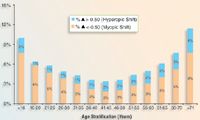Article
Data redefine refractive stability
Author(s):
Findings from analyses of a dataset including more than 250,000 patients provide new information on refractive stability in unoperated eyes and are being applied to establish refractive targets after laser vision correction with the aim of achieving better long-term satisfaction.

Key Points

The study identified patients from the Optical Express database that includes about 2.5 million records for non-laser vision correction patients examined for spectacles.
The database was searched to identify patients having a manifest refraction performed and documentation on at least two examinations occurring between January 2002 and August 2009 and with an interval of at least 3 years between visits.
Key findings
The query yielded more than 250,000 patients seen at an average of 3.9 years between visits.
Key findings from the analyses were:
■ The entire cohort had a mean sphere change of –0.07 D between the two examinations.
■ Refractive change was related to age but not gender.
■ Defining an annualized change of more than 0.50 D as significant:
• Patients with myopia were more likely to have significant regression (>0.50 D less myopia) than progression, but the magnitude of myopia did not influence myopic progression.
• Hyperopia was more likely to have significant regression (>0.50 D less hyperopia) than progression and the amount of change increased with increasing hyperopic error.
■ Cylinder was very stable, rarely progressed, but there was an increased likelihood of regression with increased cylinder.

"Current accepted criteria for refractive surgery eligibility generally require patients to demonstrate refractive stability defined by no more than 0.5 D of change in cylinder and sphere in the last 12 months," he said.

Newsletter
Don’t miss out—get Ophthalmology Times updates on the latest clinical advancements and expert interviews, straight to your inbox.





